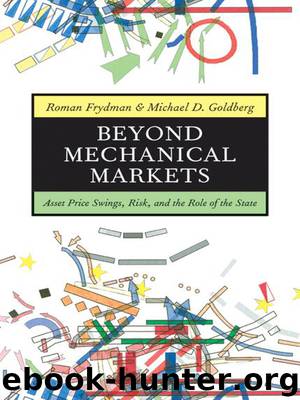Beyond Mechanical Markets by Frydman Roman Goldberg Michael D

Author:Frydman, Roman,Goldberg, Michael D.
Language: eng
Format: epub
Publisher: Princeton University Press
* * *
1The use of a 10-year trailing moving average to construct the priceearnings ratio in the figure addresses the problems that the current level of reported earnings can be quite volatile from month to month and can be negative in a month if companies' losses are large enough. Using a moving average of earnings also leads to a better measure of the benchmark level around which stock prices fluctuate. See Campbell and Shiller (1988, 1998). Of course, alternative measures of earnings (for example, operating earnings) or a longer or shorter moving average would lead to different price-earnings valuations. However, these alternative valuations would also indicate historically very high stock prices relative to underlying earnings in 1999 and 2000.
2 See also Schulmeister (2003, 2006) for an analysis of such scenarios.
3 See, for example, Shiller (2000), Brunnermeier (2001), and Akerloff and Shiller (2009) and references therein.
4 His life-long emphasis on the inadequacy of standard probabilistic portrayals of uncertainty is also seen in Keynes (1921).
5 We develop a mathematical model of asset-price swings that places imperfect knowledge about how fundamentals influence outcomes at the center of the analysis, and that also incorporates behavioral insights, in Frydman and Goldberg (2007, chapter 14; 2010b). For a nontechnical discussion, see Chapter 9.
6 For the authoritative account of Keynes and his ideas, see Skidelsky (1983, 1992, 2000, 2009).
7 Nearly all empirical studies of asset markets, however, disregard change altogether. Not surprisingly, they report little or no evidence that fundamentals matter. See Chapter 11.
8 Our discussion in this and the remaining sections of this chapter draws on Mangee's (2011) data and analysis.
9 Bloomberg Finance LP has generously allowed us access to Bloomberg Professional, which archives Bloomberg's wrap stories.
10 Mangee's data also record the qualitative relationships between movements of the factors in Tables 7.1 and 7.2 and stock prices. For example, he finds that when company earnings are reported to have mattered, their rise or fall always influences prices in the same direction. See Mangee (2011) for more details about his scoring and findings.
11 This measure of the frequency with which earnings are mentioned by Bloomberg's wrap stories includes company announcements of earnings and earnings forecasts. It also includes mentions of stock-price movements that are reported to have arisen because other informational variables, for example interest rates or sales, led participants to revise their earnings predictions. Mangee (2011) provides an alternative measure that tracks the frequency of company announcements of earnings and earnings forecasts alone; he finds that these announcements are mentioned as a main driver of stock prices on 45% of the days on average. This frequency may seem surprisingly high, given that many companies generally announce earnings over a roughly two-week period each quarter. However, it is not uncommon for companies to make earnings announcements outside of the earnings seasons.
12 Profit taking entails the decision to reduce or eliminate a profitable position to realize some or all of its gains. The Monday effect refers to the tendency of stock returns to be lower on Mondays than on other days.
Download
This site does not store any files on its server. We only index and link to content provided by other sites. Please contact the content providers to delete copyright contents if any and email us, we'll remove relevant links or contents immediately.
International Integration of the Brazilian Economy by Elias C. Grivoyannis(76465)
The Radium Girls by Kate Moore(11651)
Turbulence by E. J. Noyes(7733)
Nudge - Improving Decisions about Health, Wealth, and Happiness by Thaler Sunstein(7273)
The Black Swan by Nassim Nicholas Taleb(6792)
Rich Dad Poor Dad by Robert T. Kiyosaki(6205)
Pioneering Portfolio Management by David F. Swensen(6093)
Man-made Catastrophes and Risk Information Concealment by Dmitry Chernov & Didier Sornette(5687)
Zero to One by Peter Thiel(5517)
Secrecy World by Jake Bernstein(4418)
Millionaire: The Philanderer, Gambler, and Duelist Who Invented Modern Finance by Janet Gleeson(4127)
The Age of Surveillance Capitalism by Shoshana Zuboff(4007)
Skin in the Game by Nassim Nicholas Taleb(3993)
The Money Culture by Michael Lewis(3873)
Bullshit Jobs by David Graeber(3860)
Skin in the Game: Hidden Asymmetries in Daily Life by Nassim Nicholas Taleb(3744)
The Dhandho Investor by Mohnish Pabrai(3581)
The Wisdom of Finance by Mihir Desai(3542)
Blockchain Basics by Daniel Drescher(3345)
